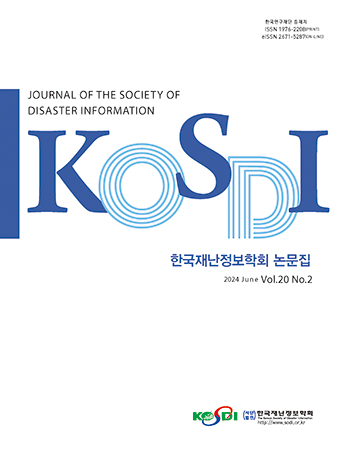Original Article
Abstract
References
Information
Purpose: This study develops a risk prediction model that predicts the risk of a fire site by using initial information such as building information and reporter acquisition information, and supports effective mobilization of fire fighting resources and the establishment of damage minimization strategies for appropriate responses in the early stages of a disaster. Method: In order to identify the variables related to the fire damage scale on the fire statistics data, a correlation analysis between variables was performed using a machine learning algorithm to examine predictability, and a learning data set was constructed through preprocessing such as data standardization and discretization. Using this, we tested a plurality of machine learning algorithms, which are evaluated as having high prediction accuracy, and developed a risk prediction model applying the algorithm with the highest accuracy. Result: As a result of the machine learning algorithm performance test, the accuracy of the random forest algorithm was the highest, and it was confirmed that the accuracy of the intermediate value was relatively high for the risk class. Conclusion: The accuracy of the prediction model was limited due to the bias of the damage scale data in the fire statistics, and data refinement by matching data and supplementing the missing values was necessary to improve the predictive model performance.
연구목적: 본 연구는 화재발생 건축물 정보, 신고자 취득 정보 등 초기 정보를 활용하여 화재현장의 위험도를 예측하여, 재난 발생 초기에 효과적인 소방자원 동원 및 적절한 대응을 위한 피해최소화 전략 수립을 지원하는 위험도 예측 모델을 개발하고자 한다. 연구방법: 화재 통계 데이터 상에서 화재의 피해규모와 관련된 변수 규명을 위해 머신러닝 알고리즘을 이용한 변수간 상관성 분석을 실시하여 예측 가능성을 검토하고, 데이터 표준화 및 이산화 등의 전처리를 통해 학습 데이터 셋을 구축하였다. 이를 활용하여 예측 정확도가 높은 것으로 평가 받고 있는 복수의 머신러닝 알고리즘을 테스트하여 가장 정확도가 높은 알고리즘을 적용한 위험도 예측 모델을 개발하였다. 연구결과: 머신러닝 알고리즘 성능 테스트 결과 랜덤포레스트 알고리즘의 정확도가 가장 높게 나왔으며, 위험도 등급에 대해서는 중간치에 대한 정확성이 상대적으로 높은 것으로 확인되었다. 결론: 화재 통계 상 피해규모 데이터의 편향성에 의해 예측모델 정확도가 제한적으로 나타났으며, 예측 모델 성능 개선을 위해 데이터 정합성 및 결손치 보완 등을 통한 데이터 정제가 필요하다.
- Chai, S.S., Jang, S.Y., Suh, D. (2018). "Design and implementation of big data analytics framework for disaster risk assessment." Journal of Digital Contents Society, Vol.19, No. 4, pp. 771-777.
- Choi, J.H., Lee, S.W., Hong, W.H. (2013). "A development of fire risk map and risk assessment model for urban residential areas by raking fire causes." Journal of the Architectural Institute of Korea Planning & Design, Vol. 29, No. 1, pp. 271-278.
- Choi, S.H. (2010). "Natural disaster damage cost prediction model based on neural network and genetic algorithm." Proceedings of the Korean Information Science Society Conference, Seoul, pp. 380-384.
- Jeong, M.G., Lee, S.H., Kim, C.S. (2020). "A study on the safety index service model by disaster sector using big data analysis." Journal of the Society of Disaster Information, Vol. 16, No, 4, pp. 682-690.
- Ko, K.S., Hwang, D.H., Park, S.J., Moon, G.G. (2018). "Electrical fire prediction model study using machine learning." The Journal of Korea Institute of Information, Electronics, and Communication Technology, Vol. 11, No. 6, pp. 703-710.
- Kwon, Y.J., Kim, D.E. (2009). "A study on the development of evaluation methods for fire risk analysis of high-rise building." Proceedings of the Korea Institute of Fire Science and Engineering Conference, Busan, pp. 270-275.
- Lee, C.Y., Kim, T.H., Cha, S.Y. (2011). "A study of the extraction algorithm of the disaster sign data from web." Journal of The Korean Society of Disaster Information, Vol. 7, No. 2, pp. 139-149.
- Lim, H.S., Lee, K.M., Cho, J.W., Lee, S.K., Min, S.H., Min, J.K. (2019). "Analysis of the relationship between fire factors and influential factors using SPSS." Journal of the Korean Society of Hazard Mitigation, Vol. 19, No. 5, pp. 103-112. 10.9798/KOSHAM.2019.19.5.103
- Park, E., Min, S. (2019). "Standardization of fire factor for big data." Journal of the Korean Society of Hazard Mitigation, Vol. 19, No. 4, pp. 143-149. 10.9798/KOSHAM.2019.19.4.143
- Ryu, J.W., Kwon, S.P. (2015). "Fire risk assessment based on weather information using data mining." Fire Science and Engineering, Vol. 29, No. 5, pp. 88-95. 10.7731/KIFSE.2015.29.5.088
- Shin, J.D., Jeong, S.H., Kim, M.S., Kim, H.J. (2012). "Analysis of fire risk with building use type using statistical data." Journal of The Korean Society of Hazard Mitigation, Vol. 12, No. 4, pp. 107-114. 10.9798/KOSHAM.2012.12.4.107
- Shin, Y.C., Koo, I.H., Hayashi, Y., Ohmiya, Y., Kwon, Y.J. (2011). "A study on the risk assessment using simulation and case study of urban fire-focusing on market." Fire Science and Engineering, Vol. 25, No. 6, pp. 1-7.
- Publisher :The Korean Society of Disaster Information
- Publisher(Ko) :한국재난정보학회
- Journal Title :Journal of the Society of Disaster Information
- Journal Title(Ko) :한국재난정보학회논문집
- Volume : 17
- No :2
- Pages :245-253
- DOI :https://doi.org/10.15683/kosdi.2021.6.30.245




 Journal of the Society of Disaster Information
Journal of the Society of Disaster Information







